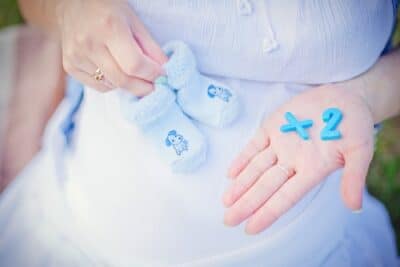Published on July 10th, 2022 and Updated on September 6th, 2025
Check out SneakPeek Gender Test to find out your baby’s gender as early as 6 weeks with over 99% accuracy!

When you’re pregnant, your body sends new sensations and signals to provide insights into its inner workings. Some of these signs may signal that double trouble lies ahead—a.k.a., twins.
For the most part, your average twin pregnancy feels the same as a single pregnancy. However, there are a few physical signs and symptoms that may indicate you’re carrying two peas in your pod.
Check out our list of 5 signs of twin pregnancy, along with other factors that increase your chances of having twins, to learn whether you’ll be seeing double in your future.
How and when do doctors confirm twin pregnancies?
While certain physical symptoms may lean toward double trouble, the only sure confirmation of twins is a medical ultrasound. A false negative pregnancy test for twins can occur as well, so it’s best to rely on a professional.
For most women, the answer will come during the first trimester ultrasound. Set around weeks 11 to 14, this scan can detect the amniotic sacs, placentas, or even body parts of twins inside the womb at 99.8% accuracy. Additionally, elevated human chorionic gonadotropin hormone (hCG) levels or high alpha-fetoprotein may prompt an earlier scan to confirm the pregnancy details.
What factors increase your likelihood of conceiving twins?
Several factors can influence your chances of having twins. Here are some of the top traits that can boost your likelihood of expecting doubles:
- Your age – If you’re pregnant and over 35, higher levels of FSH can lead to the release of two eggs, increasing the chances of twin pregnancy.
- Your weight – Women with a BMI over 30 may be more likely to get pregnant with twins due to hormonal factors that affect ovulation.
- Your family history – If you have a family history of fraternal twins, especially on your mother’s side, you may have a higher chance of pregnancy with twins.
- Your fertility treatment history – If you’ve used fertility treatments that stimulate ovulation or implant multiple embryos, your chances of being pregnant with twins are higher.
Physical symptoms when carrying twins
Until then, you can keep an eye out for the following twin pregnancy symptoms, which strongly correlate to multiple children in the womb.
#1 Your belly is growing large….very large
It makes sense—the more kids you carry, the larger your belly has to grow!
If you are carrying twins, your bump will likely be pretty large for its gestational age (a.k.a., how far along you are in your pregnancy). Medical professionals use fundal height to mark gestational age, measuring the growing distance between the top of your pubic bone and the top of your uterus (a.k.a., your fundus).
Since twins need more belly room, they usually create a higher-than-average fundal height.
But don’t break out the measuring tape just yet. Your healthcare provider typically determines fundal height during a 12-week ultrasound appointment or a separate physical exam where they’ll measure the space between the top of your pubic bone and the top of your uterus. At 12 weeks, the fundus is usually only as high as the pubic bone, making accurate at-home measurements difficult to take before this point.
However, if you’re carrying twins, you don’t really need an exact measurement—if you notice a slight bump well before 12 weeks, it could be because you have an extra womb tenant.
#2 You’re gaining weight fast
It’s normal to gain weight during pregnancy—it’s part of how your body supports your little one. But if you’re carrying twins, this weight might come on faster and heavier than usual.
For single-child pregnancies, medical professionals say that healthy pregnancy weight gain falls between 25 to 35 pounds. This weight gain usually starts slow, then picks up speed, filling in over the trimesters like so:
- First trimester (weeks 1 to 13) – add 2 to 4 pounds
- Second trimester (weeks 14 to 27) – add 12 to 20 pounds
- Third trimester (weeks 28 to 36) – add 12 to 20 pounds
Two tiny mouths to feed will increase the amount of weight gain you’ll experience. According to medical experts, most twin pregnancies should gain between 35 to 45 pounds for healthy growth. Take a look at how this weight fills in across each trimester:
- First trimester (weeks 1 to 13) – add 4 to 6 pounds
- Second trimester (weeks 14 to 27) – add 16 to 20 pounds
- Third trimester (weeks 28 to 36) – add 16 to 20 pounds
#3 You feel bumps and thumps pretty early
Kicks, bumps, shifts, thumps—they’re all exciting signs that your baby (or babies) are living it up down there.
Often referred to as “quickening,” a baby’s first movements inside the womb are a thrilling and joyous occasion. Most expecting parents feel these little flutters around 18 to 22 weeks into pregnancy.
While not research-backed yet, frequent and early fetal movement (i.e. any time before 18 weeks) could mean that you have two little dancers grooving inside of you!
#4 You’re feeling sick
Are you getting nauseous from certain food smells? Like…really nauseous? This symptom of early pregnancy could indicate a double dose of baby in your womb.
Morning sickness is a common first–trimester symptom and often a first sign of pregnancy. In fact, about 70% of pregnant women experience it. This is because hCG spikes after conception, warning your body that a baby is coming—and often triggering morning sickness. Common symptoms of morning sickness include:
- Nausea
- Vomiting
- Loss of appetite
- Fatigue
Where do twins fit into all of this? Research shows that carrying more than one baby possibly boosts hCG levels. As a result, you experience boosted ick’s and ew’s during your first few months of pregnancy.
#5 You’re tired (like, really tired)
Carrying one baby 24/7 is hard enough on your body. Carrying two? That’s a double-time job.
If you’re feeling crazy levels of fatigue while pregnant, there’s a chance you might be conceiving twins. Elevated hormones from carrying two fetuses can leave you feeling doubly exhausted, so remember to take it easy during this time and allow yourself plenty of rest.
The difference between fraternal and identical twins
Either right before or after conception, your body makes a clear distinction for twins—identical vs. fraternal.
Both biological “errors” (albeit very adorable errors), identical and fraternal twins are the result of completely different processes. Over the first few weeks, see how these types of twins come to be during pregnancy:
- Identical twins – In days following conception, identical (or monozygotic) twins form from one fertilized egg splitting into two. This is why identical twins share 100% of their DNA, creating a lookalike appearance. Identical twins account for just 0.45% of total births in the US.
- Fraternal twins – Unlike identical twins, fraternal (or dizygotic) twins come from two separate eggs and sperm cells. This is the result of hyperovulation—when an ovary releases two eggs in one ovulation cycle. When both eggs are fertilized, you get twins who share 50% of their DNA (just like normal siblings). The chances of having twins that are fraternal are slightly higher than identical twins, with fraternal twins accounting for 3.11% of total births in the US.
A complete twin pregnancy timeline
From their tiny beginnings to their big entrance, twin fetuses have quite an extraordinary journey—one that often comes with new pregnancy symptoms by week. Let’s dive into the typical fetal timeline and what you might experience along the way if you’re pregnant with twins.
First trimester: Weeks 1 to 13
Even early in your twin pregnancy, you’ll start to notice pregnancy symptoms (like that fun super-powered morning sickness we talked about).
While you’re sipping on some ginger tea, you can think about how your little ones are growing during this exciting time:
- Week 1 – After fertilization in the fallopian tubes, your egg(s) are considered single-cell zygotes. They then travel down into the uterus, rapidly dividing into more cells to become multi-cell blastocysts. At this point, if it was a single egg, the single blastocyst will split into two, to form identical twins. Fraternal twins will already be separate blastocysts.
- Week 2 – Next up, your two blastocysts will secure themselves to your uterine wall in a process known as implantation. When this happens, you might experience implantation bleeding, which looks like light spotting (but is not a period). With twin pregnancies, implantation bleeding may be more common since two blastocysts disturb the uterine lining.
- Weeks 2 to 4 – After implantation, the placenta (the organ that passes nutrients) and the amniotic sac (a protective membrane) will begin to form around the twins. For fraternal twins, each baby will get his or her own placenta and sac. For identical twins, it depends on when the single fertilized egg splits into two. About 30% will have their own placenta and sac (like fraternal twins), about 70% will share the same placenta but have their own sac, and about 1% will share the same placenta and amniotic sac.
- Weeks 5 to 8 – All major organs begin to form for your twins, alongside tiny beginnings of arms and legs. Meanwhile, helloooo fatigue and sore breasts.
- Weeks 9 to 13 – Small features like toes, fingers, and noses start to fill in here. In fact, by week 13, you can detect two little faces. You also might begin to experience other first trimester symptoms, like increased urination and food cravings.
Second trimester: Weeks 14 to 27
By the second trimester, your twins are starting to pick up speed. You’ll notice increased weight gain as they continue to grow over this timeline:
- Weeks 14 to 17 – Most expecting parents feel their quickening (or first baby movements) around week 18, but twins may start moving earlier. And in other exciting news? You can also say goodbye to many rocky first trimester symptoms—when you look at twin pregnancy symptoms week by week, the second trimester is usually a smoother journey.
- Weeks 18 to 22 – Your babies will start to act like…well, babies. Get ready for more movements as your twins kick around trying to get comfortable and start to suck their thumbs.
- Weeks 23 to 27 – Now’s the time to start practicing your lullabies. Many babies show responsiveness to noise from inside the womb at this point. Lungs and fingerprints also develop around this time.
Third trimester: Weeks 28 to 36
Now, it all comes together in two-part harmony. Here are your twins’ final growth spurts:
- Weeks 28 to 32 – Your twins are continuing to grow into their full selves, developing functioning eyes and even body hair. However, the extra weight may start to feel uncomfortable. Increased fatigue, hemorrhoids, and joint pain are common at this point.
- Weeks 33 to 36 – Single babies average 40 weeks for gestation, but twin pregnancies usually take just 36 weeks, so it’s important to be prepared for any early arrivals (as if you haven’t been preparing since the moment you received the miraculous news).
Double down on your pregnancy knowledge with SneakPeek
Twins are the ultimate surprise, and by listening to your body’s signals, you may be able to get a heads up (or dare we say, a Sneak Peak) about the two buns in your oven.
Whether you’re expecting one baby or two twin babies, we can provide a glimpse into another exciting development—the sex of your baby (or babies) to-be.
If you’re wondering how to test genders for twins, look no further than the SneakPeek At-Home Early Gender Test the only at-home fetal sex test on the market that can determine your baby’s sex with over 99% clinically proven accuracy1 as early as 6 weeks into your pregnancy. That’s months before your 18 to 20 week anatomy and gender reveal ultrasound! It’s even recommended and rated #1 by OBGYNs.
If pregnant with twins, our Early Gender Test will look for male DNA in your blood to determine if at least one of your babies is a boy. If no male DNA is detected, you can expect twin girls coming your way. If male DNA is detected, you either have a boy and a girl, or two boys. The SneakPeek Test cannot detect if both babies are boys based on the amount of male DNA, only if you’re carrying a boy at all.
Most importantly, we privacy protect your data and results, so you can trust that your information is safe with us. Join the over 1 million happy parents who chose the SneakPeek® Test and let us be your guide along your pregnancy journey.
Editorial Policy
At SneakPeek, our commitment is to provide accurate, up-to-date, and reliable information to empower our readers. Our content is thoroughly researched, reviewed by medical experts, and fact-checked to ensure its credibility. We prioritize the well-being and education of our readers, and our editorial policy adheres to the highest standards of integrity and accuracy in all our articles.
This post has been reviewed for accuracy by:
Priscilla Jeng is an accomplished digital marketing expert, currently leading as the Associate Director of Digital Marketing at Gateway Genomics, the parent company of SneakPeek. With over four years at Gateway Genomics, Priscilla has played a pivotal role in amplifying the company's mission to develop innovative genetic tests. Her proficiency in digital marketing and her comprehensive understanding of the genomics industry position her as a key contributor to SneakPeek's marketing endeavors.
Sources:
- American Pregnancy Association. First Fetal Movement: Quickening. https://americanpregnancy.org/healthy-pregnancy/pregnancy-health-wellness/first-fetal-movement/
- American Pregnancy Association. Weight Gain With Twins.
- https://americanpregnancy.org/healthy-pregnancy/multiples/weight-gain-with-multiples/
- American Society for Reproductive Medicine. Multiple Pregnancy and Birth: Twins, Triplets, and High Order Multiples. https://www.reproductivefacts.org/news-and-publications/patient-fact-sheets-and-booklets/documents/fact-sheets-and-info-booklets/multiple-pregnancy-and-birth-twins-triplets-and-high-order-multiples-booklet/
- Better Health. Twins – identical and fraternal. https://www.betterhealth.vic.gov.au/health/conditionsandtreatments/twins-identical-and-fraternal
- Better Health. Pregnancy – week by week. https://www.betterhealth.vic.gov.au/health/healthyliving/pregnancy-week-by-week
- Cleveland Clinic. Morning Sickness (Nausea and Vomiting of Pregnancy). https://my.clevelandclinic.org/health/diseases/16566-morning-sickness-nausea-and-vomiting-of-pregnancy
- Cleveland Clinic. Fundal Height. https://my.clevelandclinic.org/health/diagnostics/22294-fundal-height
- EJOG. Maternal human chorionic gonadotrophin concentrations in very early pregnancy and risk of hyperemesis gravidarum: A retrospective cohort study of 4372 pregnancies after in vitro fertilization. https://www.ejog.org/article/S0301-2115(17)30562-6/fulltext
- March of Dimes. Being Pregnant with Twins, Triplets, and Other Multiples. https://www.marchofdimes.org/complications/being-pregnant-with-twins-triplets-and-other-multiples.aspx
- Medline Plus. Gestational age. https://medlineplus.gov/ency/article/002367.htm
- Medline Plus. Is the probability of having twins determined by genetics? https://medlineplus.gov/genetics/understanding/traits/twins/
- Medline Plus. Managing your weight gain during pregnancy. https://medlineplus.gov/ency/patientinstructions/000603.htm
- NIH. First-trimester ultrasound determination of chorionicity in twin pregnancy. https://pubmed.ncbi.nlm.nih.gov/21308842/
- Parents Magazine. 6 Signs You Might Be Pregnant with Twins. https://www.parents.com/pregnancy/my-baby/twins-multiples/signs-you-might-be-pregnant-with-twins/
- Planned Parenthood. Month by Month. https://www.plannedparenthood.org/learn/pregnancy/pregnancy-month-by-month
- Verywell Family. Things That Increase Your Chances of Having Twins. https://www.verywellfamily.com/what-are-my-chances-of-having-twins-1960180
- Verywell Family. All About Identical Twins. https://www.verywellfamily.com/identical-twins-2447126#citation-4
- UCSF. Monochorionic Twins. https://fetus.ucsf.edu/monochorionic-twins/
- Columbus Obstetricians-Gynecologists, Inc. Having Twins. https://columbusobgyn.com/patient-education/having-twins/
- Verywell Family. What Are My Chances of Having Twins? https://www.verywellfamily.com/what-are-my-chances-of-having-twins-1960180
- Healthline. Seeing Double: How to Increase Your Chances of Having Twins. https://www.healthline.com/health/pregnancy/chances-of-having-twins








